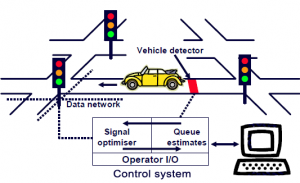What is a Smart Traffic Management System and Smart Traffic Lights?
Smart Traffic Management is a system where centrally-controlled traffic signals and sensors regulate the flow of traffic through the city in response to demand.
Cambridge is a typical small UK city. Currently it has some elements of a Smart Traffic Management system, but most traffic lights are not connected into it, and some features are not being used – see Section 6.13.2 of the Cambridge Access Audit.
Upgrading and integrating all the signals on the main roads in the city will:
- Reduce everyday congestion markedly, by smoothing traffic flows and prioritising traffic in response to demand in real time.
- Reduce pollution throughout the city: stop-start driving is inefficient and polluting.
- Give priority to buses approaching junctions, phasing lights to give traffic flowing with buses a ‘green wave’ through the city.
- Enable a much more effective response to traffic incidents, especially on the A14 and M11. The system can be pre-programmed to handle a sudden increase in traffic on any of the ten radials.
- Enable Inbound Flow Control.
It will also provide a perfect opportunity to install monitoring equipment to collect much more detailed traffic and journey data than we have now. Each set of traffic lights will have communication equipment that can be used to transmit (anonymous) vehicle data, either from ANPR cameras or Bluetooth detectors, and CCTV feeds (where appropriate).
Not knowing the state of the current traffic control centre, it might be that investment is needed to upgrade or create a new state-of-the-art suite for monitoring and controlling traffic.
How much will it cost?
Cambridge already has a SCOOT Urban Traffic Management and Control (UTMC) system and Common Database (CDB): this is detailed in Section 3.7.2 of the Cambridge Access Audit.
There are approximately 120 sets of traffic signals in the city, not all of which will need to be upgraded or integrated. Allowing £100k per set of traffic lights, including installing vehicle sensors and upgrading nearby cycle/pedestrian crossings, a budget of £10m should be adequate, which represents just 10% of the first £100m of City Deal money. There may however be a case for investing more.
When can we have it?
Because it would not require lengthy consultation, land purchases or access agreements, delivery could start within a year, on a rolling programme over two to three years. Disruption at each junction would last for a matter of days or, at most, weeks. Benefits would be experienced within months of starting the programme.
How does it work?

There are three components: traffic lights, queue detectors buried in the road and/or cameras, and a central control system. The queue detectors tell the control system the state of traffic flow on all the main roads in the city. The system in turn controls the lights to maintain a free flow of traffic within the city.
Every two seconds the system uses a model of real-world conditions to decide whether there would be an advantage in changing the phasing of any of the lights. What the system software considers an ‘advantage’ may be defined as punctual buses, lower pollution at a particular location, or fewer vehicles queuing on a motorway slip ramp.
If Inbound Flow Control is used, the outermost sets of traffic lights on arterial or radial roads serve a special function and are known technically as ‘gates’ or ‘control points’. These regulate the flow of vehicles entering the city. You may already have experienced gating in Cambridge, on Newmarket Road or Trumpington Road, where lights at the end of the bus lanes hold back traffic to give buses priority. You may also have experienced ramp metering, where traffic is held back on a slip ramp onto a motorway, smoothing the rate at which traffic joins, and thereby preventing congestion.
The software (SCOOT) has been developed over decades, and is used in hundreds of cities throughout Europe, including Cambridge, to co-ordinate traffic signals, typically to give priority to buses. There are at least three cities where the system is used to control all traffic into the city, much as we are proposing for Cambridge: Zurich, Braunschweig and Potsdam.
The software would be set up with ‘knowledge’ of the road network and trained to respond appropriately to a wide range of scenarios, including major disruption caused, say, by an accident on the A14. But it can also be manually overridden if necessary.


